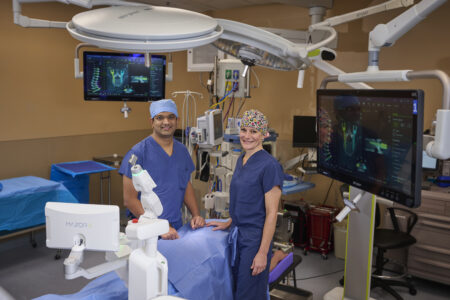After a breast cancer diagnosis, Senior Resource Center leader is raising awareness about problems that mammograms might not catch

“I’ll always kick myself a little bit because I could have caught it earlier, but I don’t think there’s anything I could have done to prevent it.”
Megan Poindexter had a weird pain in her armpit. She didn’t think it was anything serious, so she ignored it and went on about life. When it was time for her annual well woman check, the pain had been around for quite a while. She met with her primary care physician, Dr. Samantha Durland, and she did a breast exam during the visit. Nothing seemed out of place.
“I mentioned the pain to Dr. Durland because it had been on my mind. I wouldn’t have thought a lot about it, except that my mom had breast cancer and it was in that general area,” Poindexter said. “The doctor agreed that it was strange and recommended an ultrasound and mammogram to see what was going on.”
Those tests didn’t yield any concerning findings, so Poindexter continued her normal day-to-day routine. She began having other strange symptoms during the late summer, including pain in her arm and elbow that continued to get worse. It got so bad that she couldn’t reach up to get a glass or grab winter hats off the top shelf of the closet.
“I grew up as an athlete, so I’m not really fazed by aches and pains and I blew it off,” Poindexter said. “But the day after Christmas in 2022, I thought to myself that it was ridiculous that my arm had been hurting for months. I was due for another well woman exam and thought Dr. Durland would give me a physical therapy referral.”
As fate would have it, something changed that night. Poindexter stretched her arm upward and as she moved to pull her bra back down, her thumb hit a lump.
“I don’t know how I’d never felt it before. It was already really large,” she said. “If I’d been doing a breast self-examination — if I’d been paying attention — I would have felt it sooner than that, but it wasn’t there the year before during my last exam.”
Poindexter saw Durland right away, and she provided a referral for a mammogram at the LMH Health West Campus. Even though both Poindexter and her doctor could feel the lump, it wasn’t visible on the mammogram. She was ushered directly over for an ultrasound but the sonographer wasn’t able to get a clear image, though it did show a suspicious mass. She was immediately scheduled for a biopsy.
Dense tissue makes a difference
Poindexter knew there was a lump in her breast, so why wasn’t it detected? Her breast density played a big role.
A high percentage of fibrous and glandular tissue compared to fatty tissue means your breast tissue is “dense.”
“We measure breast density from A to D, where A is fatty and D is extremely dense,” said Dr. Jennifer Hawasli, a surgeon with Lawrence Breast Specialists. “As we age, we generally move from having dense breasts to more fatty. Dense tissue is harder to see through on a mammogram, which is one of the reasons we don’t routinely recommend them for people in their 20s and 30s if they don’t have a family history of cancer and aren’t having any concerns.”
Beginning screening mammograms at age 40 is recommended for those without symptoms or a history of cancer. LMH Health has a program that helps identify those at higher risk based on breast density and a lifetime risk assessment, and providing screenings and genetic testing.
“Insurance may not cover those costs entirely, but I want patients to know the options that are available to them,” she said. “LMH Health offers an abbreviated breast MRI for $250 out-of-pocket, which can make it much more affordable.”
Mammograms are still the standard for screening, but Hawasli recommends that those who have dense breasts combine mammograms with an MRI. Patients have one of the tests every six months and meet with Hawasli and an oncologist semiannually.
Breaking the news
Breast cancer runs in Poindexter’s family. Her mother, uncle, aunt, great-aunt and grandmother all had the disease. The sonographer could see that several of Poindexter’s lymph nodes were abnormal. A biopsy was performed immediately and an MRI was ordered. They confirmed her fears. There was cancer. Hawasli called and broke the news.
“It was January 5. I remember standing on the sidewalk outside the school picking up my kids when she called,” Poindexter said. “Dr. Hawasli had already gotten home when the pathology results came in but she knew I needed the results before the weekend so that I wasn’t just wondering. She was so compassionate.”
One of the next steps was to determine the type of breast cancer Poindexter had. The team needed to learn what hormones her cancer contained in order to develop a treatment plan. They identified Poindexter’s breast cancer as a stage two carcinoma that was positive for estrogen and progesterone hormones and HER-2 protein.
Dr. Sherri Soule, an oncologist at the LMH Health Cancer Center, explained this diagnosis helps guide the treatment plan and determine whether neoadjuvant chemotherapy — where chemo is administered before surgery — was needed.
“Megan’s pathology showed that she was HER-2 positive,” Soule said. “She required neoadjuvant chemo, and this finding helped set the course of her regimen and its schedule.”
Anyone who knows Poindexter knows that she is a planner. When she received her diagnosis, she began laying out calendars and plans for her treatment schedule, then surgery.
“When Dr. Soule told me about the change to the pathology report, she said that we’d do chemo and then the mastectomy, followed by immunotherapy and radiation. It was a good wakeup call and a reminder that I’m not in charge of this disease,” Poindexter said. “You just have to figure out how to go with the flow.”
Pragmatic as always, Poindexter took in her diagnosis and created a game plan. She called her family and best friends before sharing the news with the staff and board of directors at the Senior Resource Center where she is the executive director. Then it was time to share the news with the world.
“Feels surreal to share this,” she posted on Facebook, “and there are so many of you I wish I could tell in person…but…Here’s a firm reminder for the ladies to do your self exams (and gents, you’ve got your things, too). I have received a breast cancer diagnosis and will be starting treatments in the near future. I am so fortunate to have a wonderful support network who I know will be with me as I navigate this path.”
Not all seas are smooth sailing
After having a port to deliver the chemotherapy placed in her chest a few days prior, Poindexter’s first treatment was February 1, 2023. When treatment consists of multiple drugs all vying to destroy the cancer cells in the body, there can be some nasty side effects. Soule explained that hair loss, nausea, neuropathy, bone and joint pain, altered taste and exhaustion are all common.
Poindexter was able to mitigate most of the side effects, including a pretty nasty case of chemo mouth, which occurs when the inside of the mouth becomes red and swollen, but one of the most terrifying was the brain fog. She often works with people diagnosed with brain disease, including Alzheimer’s, dementia and Parkinson’s, and it increased Poindexter’s empathy for those who live with those symptoms.
“Here I am, trying to be the director of the Senior Resource Center. Trying to continue to be responsive and keep on top of the puzzle pieces that are the business side of the organization, while trying to be a mom for my kids,” she explained. “All of the fog was really scary for me. I couldn’t help but think, ‘What if this never goes away? What if this is my new normal?'”
Her last chemo treatment was May 17 and Poindexter had some time to recover before the next leg of the journey — a bilateral mastectomy and axillary lymph node dissection. On June 28, Hawasli removed both of Poindexter’s breasts and ten lymph nodes that were whisked away to pathology.
A few days later, Soule shared the news that five of the ten lymph nodes showed cancer. While they’d hoped that they’d all be cancer-free, it wasn’t a shock. The good news was that the tumors had shrunk and the margins around the tumors were clear.
Poindexter’s cancer journey wasn’t over, as the pathology report meant she would continue to adjust to changes in her treatment plan. Radiation had already been expected, but a different type of IV infusion was recommended. After completing both of those treatments, she’d take an oral immunotherapy drug for a year plus an estrogen blocker for ten years. Then there’d be an end in sight to active treatment.
Looking forward
Poindexter isn’t going to sit idly. She’s working with a physical therapist to get her lymphedema (swelling caused by fluid build-up) under control and return to being active and athletic.
“I don’t have any guarantees that my cancer won’t come back. We know the aggressive nature of what I had,” she said. “But I do have an opportunity to try and do something positive with my experience.”
From talking with friends living around the country, Poindexter knows that even though it’s becoming the standard of care for people with dense breasts, an MRI isn’t the normal screening standard for breast cancer at all institutions. She wants people to advocate for themselves, especially if they have dense breasts.
“I had a lump that was very, very big. Because my breasts were so dense, the mammogram couldn’t see it, and the ultrasound couldn’t clearly see it. When they did an MRI, it wasn’t just the one lump — there were a whole bunch of them,” she said. “Dense breast tissue isn’t a good match for a mammogram. We need to do better, to push harder and advocate.”
If you feel any changes in your breast, even if you’ve just had a mammogram, Hawasli emphasized that you should always get another exam.
“Mammograms aren’t perfect. The National Cancer Institute estimates they can miss 1 out of 10 cancers that are present at the time of screening and one cause is high breast density,” she said.
In fact, this new knowledge has already benefited someone close to Poindexter. After encouraging her sister to get additional screening, Poindexter’s sister was also diagnosed with breast cancer. But her sister’s cancer was caught much earlier, allowing for a less complex treatment plan.
When you’re ready to have a screening MRI, turn to LMH Health. Soule shared that patients can schedule within a few days and if a biopsy is needed, those can be scheduled within the week.
“We take care of patients more personally at LMH. We have a tight physician group and teams that work collaboratively to provide world-class care,” she said. “The people in our community are our friends and neighbors and we want to care for you right here, close to home.”
Poindexter agrees. When she was deciding where to seek treatment, she called Durland to go through the pros and cons about different health systems. Everything Durland shared and feedback from everyone she spoke with helped Poindexter realize that the team at LMH Health was the right fit. She would get identical treatment to what would be provided at a larger hospital, and she’d get it in her own backyard.
“I didn’t hear anything that made me think of going anywhere other than LMH Health,” she said. “It’s practically a stone’s throw from my desk downtown to the Cancer Center. Being able to get such great care in my community has been amazing. I wouldn’t go anywhere else.”
— Autumn Bishop is the marketing manager and content strategist for LMH Health, which is a sponsor of the Lawrence Journal-World health section.





